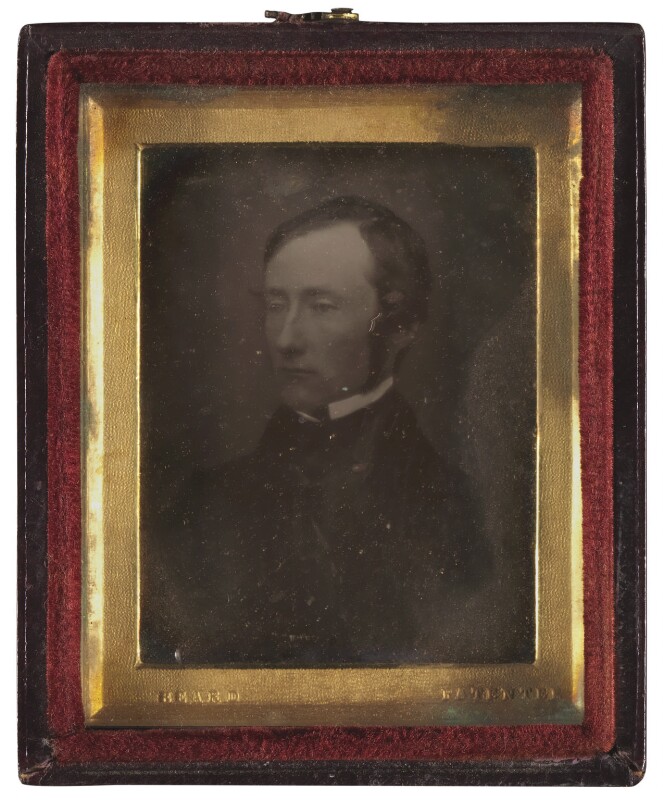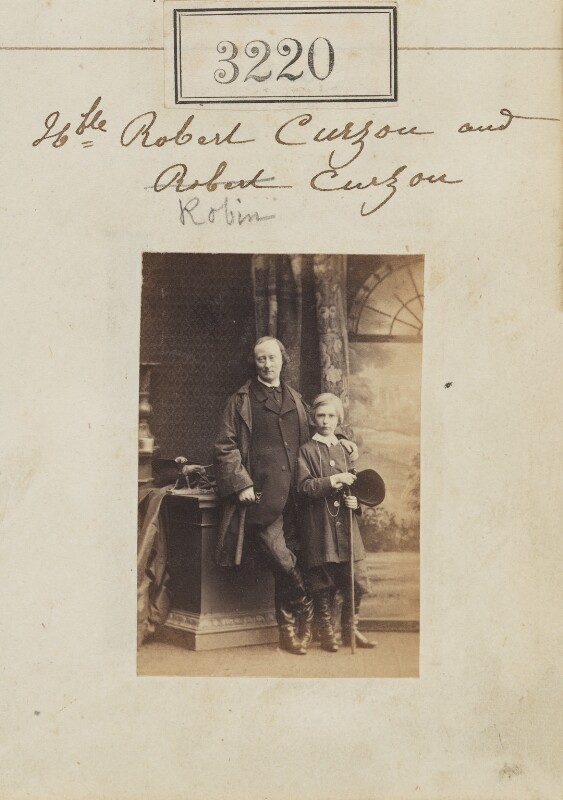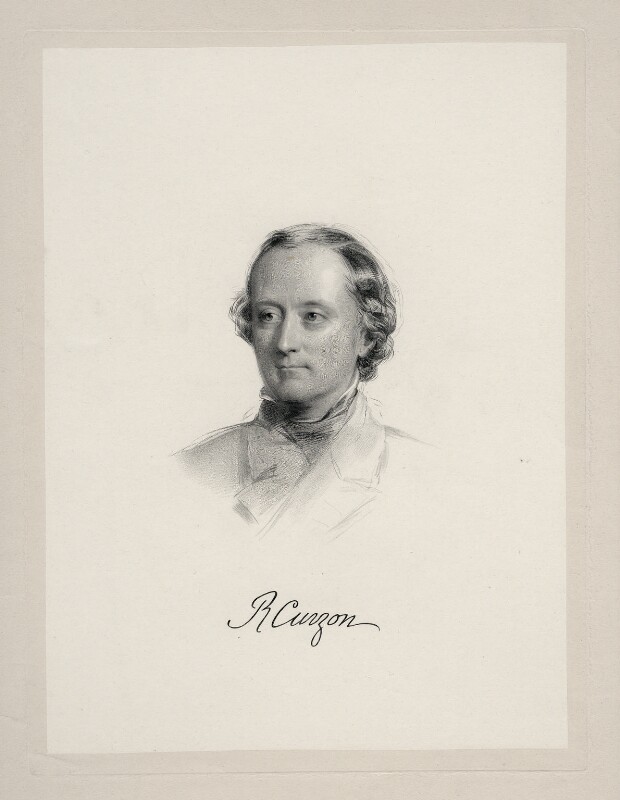Module: Robert Curzon

A daguerreotype (early photograph) of Robert Curzon made in the 1840s by Richard Beard (1801-1885). © National Portrait Gallery, London. Used by permission. https://www.npg.org.uk/collections/search/portrait/mw07008 
Photograph (albumen print) of Robert Curzon with his son (also Robert) taken April 21, 1861 by photographer Camille Silvy (1834-1910). © National Portrait Gallery, London. Used by permission. https://www.npg.org.uk/collections/search/portrait/mw276207 
Engraving (1859) of Robert Curzon by William Holl Jr (1807-1871) after a painting (?) by George Richmond (1809-1896). © National Portrait Gallery, London. Used by permission. https://www.npg.org.uk/collections/search/portrait/mw114598
Robert Curzon (1810–1873), who later became the 14th Baron Zouche, was one of the primary British manuscript collectors of the 19th century. He is also the author of a bestselling travel account (Visits to Monasteries in the Levant). In his travels to Greece (Mount Athos), Armenia, and the Middle East, he acquired (and attempted to acquire) manuscripts in Greek, Coptic, Syriac, Hebrew, Arabic, and other languages. When he died, more than 200 of his manuscripts were loaned to the British Museum and were eventually bequeathed to it in 1917 upon the death of his daughter, Darea .
For a general account of his life, see the three following obituaries:
The late Lord Zouche.—Our obituary column yesterday contained the name of a nobleman, Lord Zouche, who was better known by his former designation as the Hon. Robert Curzon and as the author of The Monasteries of the Levant. Lord Zouche, who died on Saturday at Parham-park, his seat near Petsworth, Sussex, at the age of 63, was the elder son of the late Harriet Anne (in her own right) Baroness Zouche, or De la Zouche, by the Hon. Robert Curzon, youngest cousin of the first Viscount Curzon. He was born in London in March, 1810, and was educated at the Charter-house under Dr. Russell, and subsequently at Christ Church, Oxford. Entering the diplomatic service, he became an Attaché at Constantinople, and was employed as joint Commissioner on behalf of this country at the Conference of Erzereum. He acted also for some time as Private Secretary to our Ambassador at the Porte, Lord Stratford de Redcliffe, through whose influence in Turkey and Greece he obtained access to the various religious houses, convents, and monasteries in the districts bordering on the Levant—houses which he so charmingly described in the volume above-mentioned, and from which he was enabled to bring to Europe many curious and valuable treasures. He was also the author of another work entitled Armenia, or a Residence at Erzeroum. He sat in the unreformed House of Commons for a short time in 1831, as M.P for the borough of Clitheroe, and succeeded to the family title and estates on his „mother’s death,“ in The Times (1870)
2336801 {2336801:Y393TWA9} 1 chicago-author-date 50 default 63 https://www.manuscripthunters.gwi.uni-muenchen.de/wp-content/plugins/zotpress/%7B%22status%22%3A%22success%22%2C%22updateneeded%22%3Afalse%2C%22instance%22%3Afalse%2C%22meta%22%3A%7B%22request_last%22%3A0%2C%22request_next%22%3A0%2C%22used_cache%22%3Atrue%7D%2C%22data%22%3A%5B%7B%22key%22%3A%22Y393TWA9%22%2C%22library%22%3A%7B%22id%22%3A2336801%7D%2C%22meta%22%3A%7B%22lastModifiedByUser%22%3A%7B%22id%22%3A3129206%2C%22username%22%3A%22rvollandt%22%2C%22name%22%3A%22%22%2C%22links%22%3A%7B%22alternate%22%3A%7B%22href%22%3A%22https%3A%5C%2F%5C%2Fwww.zotero.org%5C%2Frvollandt%22%2C%22type%22%3A%22text%5C%2Fhtml%22%7D%7D%7D%2C%22parsedDate%22%3A%221873-08-07%22%2C%22numChildren%22%3A0%7D%2C%22bib%22%3A%22%26lt%3Bdiv%20class%3D%26quot%3Bcsl-bib-body%26quot%3B%20style%3D%26quot%3Bline-height%3A%201.35%3B%20padding-left%3A%201em%3B%20text-indent%3A-1em%3B%26quot%3B%26gt%3B%5Cn%20%20%26lt%3Bdiv%20class%3D%26quot%3Bcsl-entry%26quot%3B%26gt%3B%26lt%3Bi%26gt%3BThe%20Times%26lt%3B%5C%2Fi%26gt%3B.%201873.%20%26%23x201C%3BObituary%3A%20Robert%20Curzon%2C%2014th%20Baron%20Zouche%2C%26%23x201D%3B%20August%207%2C%201873.%20Wikisource.%20%26lt%3Ba%20class%3D%26%23039%3Bzp-ItemURL%26%23039%3B%20href%3D%26%23039%3Bhttps%3A%5C%2F%5C%2Fen.wikisource.org%5C%2Fwiki%5C%2FThe_Times%5C%2F1873%5C%2FObituary%5C%2FRobert_Curzon%26%23039%3B%26gt%3Bhttps%3A%5C%2F%5C%2Fen.wikisource.org%5C%2Fwiki%5C%2FThe_Times%5C%2F1873%5C%2FObituary%5C%2FRobert_Curzon%26lt%3B%5C%2Fa%26gt%3B.%26lt%3B%5C%2Fdiv%26gt%3B%5Cn%26lt%3B%5C%2Fdiv%26gt%3B%22%2C%22data%22%3A%7B%22itemType%22%3A%22newspaperArticle%22%2C%22title%22%3A%22Obituary%3A%20Robert%20Curzon%2C%2014th%20Baron%20Zouche%22%2C%22creators%22%3A%5B%5D%2C%22abstractNote%22%3A%22%22%2C%22date%22%3A%221873-08-07%22%2C%22section%22%3A%22%22%2C%22language%22%3A%22en%22%2C%22ISSN%22%3A%22%22%2C%22url%22%3A%22https%3A%5C%2F%5C%2Fen.wikisource.org%5C%2Fwiki%5C%2FThe_Times%5C%2F1873%5C%2FObituary%5C%2FRobert_Curzon%22%2C%22collections%22%3A%5B%5D%2C%22dateModified%22%3A%222020-07-01T10%3A45%3A45Z%22%7D%7D%5D%7DThe Times. 1873. “Obituary: Robert Curzon, 14th Baron Zouche,” August 7, 1873. Wikisource. https://en.wikisource.org/wiki/The_Times/1873/Obituary/Robert_Curzon.
Curzon, Robert, 1s. Robert, of Marylebone, London, arm. Christ Church, matric. 19 Feb., 1828, aged 17; 14th Baron Zouche on his mother’s death 15 May, 1870, M.P. Clitheroe 1831-2, died 2 Aug., 1873. See Foster’s Peerage.
2336801 {2336801:C66X9HAR} 1 chicago-author-date 50 default 63 https://www.manuscripthunters.gwi.uni-muenchen.de/wp-content/plugins/zotpress/%7B%22status%22%3A%22success%22%2C%22updateneeded%22%3Afalse%2C%22instance%22%3Afalse%2C%22meta%22%3A%7B%22request_last%22%3A0%2C%22request_next%22%3A0%2C%22used_cache%22%3Atrue%7D%2C%22data%22%3A%5B%7B%22key%22%3A%22C66X9HAR%22%2C%22library%22%3A%7B%22id%22%3A2336801%7D%2C%22meta%22%3A%7B%22lastModifiedByUser%22%3A%7B%22id%22%3A3129206%2C%22username%22%3A%22rvollandt%22%2C%22name%22%3A%22%22%2C%22links%22%3A%7B%22alternate%22%3A%7B%22href%22%3A%22https%3A%5C%2F%5C%2Fwww.zotero.org%5C%2Frvollandt%22%2C%22type%22%3A%22text%5C%2Fhtml%22%7D%7D%7D%2C%22creatorSummary%22%3A%22Foster%22%2C%22parsedDate%22%3A%221891%22%2C%22numChildren%22%3A0%7D%2C%22bib%22%3A%22%26lt%3Bdiv%20class%3D%26quot%3Bcsl-bib-body%26quot%3B%20style%3D%26quot%3Bline-height%3A%201.35%3B%20padding-left%3A%201em%3B%20text-indent%3A-1em%3B%26quot%3B%26gt%3B%5Cn%20%20%26lt%3Bdiv%20class%3D%26quot%3Bcsl-entry%26quot%3B%26gt%3BFoster%2C%20Joseph.%201891.%20%26%23x201C%3BCurzon%2C%20Robert%20%282%29.%26%23x201D%3B%20In%20%26lt%3Bi%26gt%3BAlumni%20Oxonienses%3A%20The%20Members%20of%20the%20University%20of%20Oxford%2C%201715-1886%26lt%3B%5C%2Fi%26gt%3B.%20Oxford%3A%20Parker%20%26amp%3B%20Co.%20%26lt%3Ba%20class%3D%26%23039%3Bzp-ItemURL%26%23039%3B%20href%3D%26%23039%3Bhttps%3A%5C%2F%5C%2Fen.wikisource.org%5C%2Fwiki%5C%2FAlumni_Oxonienses%3A_the_Members_of_the_University_of_Oxford%2C_1715-1886%5C%2FCurzon%2C_Robert_%282%29%26%23039%3B%26gt%3Bhttps%3A%5C%2F%5C%2Fen.wikisource.org%5C%2Fwiki%5C%2FAlumni_Oxonienses%3A_the_Members_of_the_University_of_Oxford%2C_1715-1886%5C%2FCurzon%2C_Robert_%282%29%26lt%3B%5C%2Fa%26gt%3B.%26lt%3B%5C%2Fdiv%26gt%3B%5Cn%26lt%3B%5C%2Fdiv%26gt%3B%22%2C%22data%22%3A%7B%22itemType%22%3A%22bookSection%22%2C%22title%22%3A%22Curzon%2C%20Robert%20%282%29%22%2C%22creators%22%3A%5B%7B%22creatorType%22%3A%22author%22%2C%22firstName%22%3A%22Joseph%22%2C%22lastName%22%3A%22Foster%22%7D%5D%2C%22abstractNote%22%3A%22%22%2C%22bookTitle%22%3A%22Alumni%20Oxonienses%3A%20the%20Members%20of%20the%20University%20of%20Oxford%2C%201715-1886%22%2C%22date%22%3A%221891%22%2C%22language%22%3A%22%22%2C%22ISBN%22%3A%22%22%2C%22url%22%3A%22https%3A%5C%2F%5C%2Fen.wikisource.org%5C%2Fwiki%5C%2FAlumni_Oxonienses%3A_the_Members_of_the_University_of_Oxford%2C_1715-1886%5C%2FCurzon%2C_Robert_%282%29%22%2C%22collections%22%3A%5B%5D%2C%22dateModified%22%3A%222020-07-01T10%3A45%3A32Z%22%7D%7D%5D%7DFoster, Joseph. 1891. “Curzon, Robert (2).” In Alumni Oxonienses: The Members of the University of Oxford, 1715-1886. Oxford: Parker & Co. https://en.wikisource.org/wiki/Alumni_Oxonienses:_the_Members_of_the_University_of_Oxford,_1715-1886/Curzon,_Robert_(2).
CURZON, ROBERT, fourteenth Baron Zouche (or de la Zouche) of Harringworth (1810–1873), elder son of Harriet Anne Bisshopp, in her own right Baroness Zouche, by the Hon. Robert Curzon, son of Assheton, first viscount Curzon, was born at London on 16 March 1810. He was educated at the Charterhouse, and entered Christ Church, Oxford, as a gentleman commoner in 1829, but left without taking his degree in 1831, when he was returned by Clitheroe to the House of Commons. The borough was disfranchised in 1832, and Curzon never sat for another. In 1833 he began those travels which have made his name renowned. He visited Egypt and the Holy Land in 1833–4, on a tour of research among the monastery libraries, whence he succeeded in rescuing many valuable manuscripts and showed the way to other explorers, such as Dr. Tattam. Continuing his investigations in the Meliora convents of Albania, he finally in 1837 visited Mount Athos and its colony of monks. His varied experiences are recorded in his ‘Visit to the Monasteries in the Levant’ (1849), one of the most charming books of travel ever written and a worthy companion even to ‘Eothen.’ It immediately took hold of the popular fancy; three editions were issued in 1849, a fourth in 1851, a fifth in 1865, and a sixth (the latest) in 1881. From a scientific point of view, also, these revelations of monastic treasures were of great importance, and it was Curzon’s experience that set others on the track which led to the acquisition of the magnificent collection of Nitrian manuscripts by the British Museum.
In October 1841 he was appointed attaché at the embassy at Constantinople and private secretary to Sir Stratford Canning (afterwards Viscount Stratford de Redcliffe). Here his antiquarian tastes found a congenial soil, and it is recorded that, without shirking work that was required of him, he greatly preferred a ramble in the bazaars or among the ruined vestiges of Old Stamboul to the copying of even the most exciting of his chief’s famous despatches. In January 1843 he was appointed a commissioner, conjointly with Lieutenant-colonel (afterwards Sir W. Fenwick) Williams, for defining the boundaries between Turkey and Persia, and he remained, at Erzeroum for the most part, engaged in this task until January 1844, when he returned to England. In recognition of his services the shah and sultan bestowed upon him respectively the decorations of the Lion and Sun of Persia and the Nishan (or ‘Pour le mérite’) of Turkey. His impressions of the country, derived from a year’s residence, are published in his ‘Armenia,’ of which three editions appeared in 1854. In the meanwhile he had married in 1850 Emily, daughter of Sir R. Wilmot-Horton, by whom he left issue the fifteenth Baron Zouche (b. 1851) and a daughter. His later travels in Italy were devoted partly to the same object which had inspired his early explorations of the Levantine and Egyptian monasteries—the discovery of manuscripts; and the Philobiblon Society published in 1854 his ‘Account of the most celebrated Libraries of Italy.’ His interest in manuscripts, however, was at least as much excited by the actual writing as by the contents. He was a student of the history of handwriting, and his valuable collection of manuscripts had been gathered with a view to an exhaustive treatise on the subject, which he never completed. In 1849, indeed, he printed fifty copies of his ‘Catalogue of Materials for Writing, Early Writings on Tablets and Stones, Rolled and other MSS. … and Books in the Library at Parham,’ which comprised examples in Syriac, Arabic, Turkish, Uigur, Persian, Armenian, Greek, and Coptic, and upon which he intended to found a larger work. These manuscripts have lately been temporarily deposited by his son in the charge of the department of manuscripts at the British Museum. The only other work he published, and that in an edition of thirty copies, was the ‘Lay of the Purple Falcon,’ 1847, a poem in archaic style, professing to be a translation of a manuscript at Parham. The earlier part of the ‘Lay’ was really written by Bishop Heber, and Curzon completed it. In 1870 he succeeded his mother in the barony. The title was originally created by writ in 1308 in the person of William le Zouche, son of Eudo, a younger brother of Alan, baron Zouche of Ashby. It fell into abeyance in 1625, and was not revived till Sir Cecil Bisshopp made good his claim in 1815. On his death the barony again fell into abeyance between his two daughters, but this was terminated by the crown in favour of the elder. Lord Zouche was deputy lieutenant of Sussex and Staffordshire, where his estates of Parham and Ravenhill are situated. He died at Parham on 2 Aug. 1873, at the age of sixty-three.
[Times, 7 Aug. 1873; private information; Foster’s Peerage.]S. L-P.
2336801 {2336801:TJLX7KDT} 1 chicago-author-date 50 default 63 https://www.manuscripthunters.gwi.uni-muenchen.de/wp-content/plugins/zotpress/%7B%22status%22%3A%22success%22%2C%22updateneeded%22%3Afalse%2C%22instance%22%3Afalse%2C%22meta%22%3A%7B%22request_last%22%3A0%2C%22request_next%22%3A0%2C%22used_cache%22%3Atrue%7D%2C%22data%22%3A%5B%7B%22key%22%3A%22TJLX7KDT%22%2C%22library%22%3A%7B%22id%22%3A2336801%7D%2C%22meta%22%3A%7B%22lastModifiedByUser%22%3A%7B%22id%22%3A3129206%2C%22username%22%3A%22rvollandt%22%2C%22name%22%3A%22%22%2C%22links%22%3A%7B%22alternate%22%3A%7B%22href%22%3A%22https%3A%5C%2F%5C%2Fwww.zotero.org%5C%2Frvollandt%22%2C%22type%22%3A%22text%5C%2Fhtml%22%7D%7D%7D%2C%22creatorSummary%22%3A%22Lane-Poole%22%2C%22parsedDate%22%3A%221888%22%2C%22numChildren%22%3A0%7D%2C%22bib%22%3A%22%26lt%3Bdiv%20class%3D%26quot%3Bcsl-bib-body%26quot%3B%20style%3D%26quot%3Bline-height%3A%201.35%3B%20padding-left%3A%201em%3B%20text-indent%3A-1em%3B%26quot%3B%26gt%3B%5Cn%20%20%26lt%3Bdiv%20class%3D%26quot%3Bcsl-entry%26quot%3B%26gt%3BLane-Poole%2C%20Stanley.%201888.%20%26%23x201C%3BCurzon%20Robert.%26%23x201D%3B%20In%20%26lt%3Bi%26gt%3BDictionary%20of%20National%20Biography%2C%201885-1900%26lt%3B%5C%2Fi%26gt%3B%2C%20edited%20by%20Leslie%20Stephen.%20Vol.%20Volume%2013.%20London%3A%20Elder%20Smith%20%26amp%3B%20Co.%20Wikisource.%20%26lt%3Ba%20class%3D%26%23039%3Bzp-ItemURL%26%23039%3B%20href%3D%26%23039%3Bhttps%3A%5C%2F%5C%2Fen.wikisource.org%5C%2Fwiki%5C%2FCurzon%2C_Robert_%28DNB00%29%26%23039%3B%26gt%3Bhttps%3A%5C%2F%5C%2Fen.wikisource.org%5C%2Fwiki%5C%2FCurzon%2C_Robert_%28DNB00%29%26lt%3B%5C%2Fa%26gt%3B.%26lt%3B%5C%2Fdiv%26gt%3B%5Cn%26lt%3B%5C%2Fdiv%26gt%3B%22%2C%22data%22%3A%7B%22itemType%22%3A%22encyclopediaArticle%22%2C%22title%22%3A%22Curzon%20Robert%22%2C%22creators%22%3A%5B%7B%22creatorType%22%3A%22author%22%2C%22firstName%22%3A%22Stanley%22%2C%22lastName%22%3A%22Lane-Poole%22%7D%2C%7B%22creatorType%22%3A%22editor%22%2C%22firstName%22%3A%22Leslie%22%2C%22lastName%22%3A%22Stephen%22%7D%5D%2C%22abstractNote%22%3A%22%22%2C%22encyclopediaTitle%22%3A%22Dictionary%20of%20National%20Biography%2C%201885-1900%22%2C%22date%22%3A%221888%22%2C%22ISBN%22%3A%22%22%2C%22url%22%3A%22https%3A%5C%2F%5C%2Fen.wikisource.org%5C%2Fwiki%5C%2FCurzon%2C_Robert_%28DNB00%29%22%2C%22language%22%3A%22%22%2C%22collections%22%3A%5B%5D%2C%22dateModified%22%3A%222020-07-01T10%3A58%3A12Z%22%7D%7D%5D%7DLane-Poole, Stanley. 1888. “Curzon Robert.” In Dictionary of National Biography, 1885-1900, edited by Leslie Stephen. Vol. Volume 13. London: Elder Smith & Co. Wikisource. https://en.wikisource.org/wiki/Curzon,_Robert_(DNB00).
For a more detailed biography, consult the following:
- 2336801 {2336801:YJ9ZSCBM} 1 chicago-author-date 50 default 63 https://www.manuscripthunters.gwi.uni-muenchen.de/wp-content/plugins/zotpress/(use the Google Preview or see in the Library if you’re logged in)%7B%22status%22%3A%22success%22%2C%22updateneeded%22%3Afalse%2C%22instance%22%3Afalse%2C%22meta%22%3A%7B%22request_last%22%3A0%2C%22request_next%22%3A0%2C%22used_cache%22%3Atrue%7D%2C%22data%22%3A%5B%7B%22key%22%3A%22YJ9ZSCBM%22%2C%22library%22%3A%7B%22id%22%3A2336801%7D%2C%22meta%22%3A%7B%22creatorSummary%22%3A%22Cormack%22%2C%22parsedDate%22%3A%222000%22%2C%22numChildren%22%3A1%7D%2C%22bib%22%3A%22%26lt%3Bdiv%20class%3D%26quot%3Bcsl-bib-body%26quot%3B%20style%3D%26quot%3Bline-height%3A%201.35%3B%20padding-left%3A%201em%3B%20text-indent%3A-1em%3B%26quot%3B%26gt%3B%5Cn%20%20%26lt%3Bdiv%20class%3D%26quot%3Bcsl-entry%26quot%3B%26gt%3BCormack%2C%20Robin.%202000.%20%26%23x201C%3B%26%23x2018%3BA%20Gentleman%26%23x2019%3Bs%20Book%26%23x2019%3B%3A%20Attitudes%20of%20Robert%20Curzon.%26%23x201D%3B%20In%20%26lt%3Bi%26gt%3BThrough%20the%20Looking%20Glass%3A%20Byzantium%20through%20British%20Eyes%3A%20Papers%20from%20the%20Twenty-Ninth%20Spring%20Symposium%20of%20Byzantine%20Studies%2C%20King%26%23x2019%3Bs%20College%2C%20London%2C%20March%201995%26lt%3B%5C%2Fi%26gt%3B%2C%20edited%20by%20Robin%20Cormack%20and%20Elizabeth%20Jeffreys%2C%20147%26%23x2013%3B60.%20Aldershot%3A%20Variorum.%20%26lt%3Ba%20class%3D%26%23039%3Bzp-ItemURL%26%23039%3B%20href%3D%26%23039%3Bhttps%3A%5C%2F%5C%2Fbooks.google.de%5C%2Fbooks%3Fid%3DKpqoDQAAQBAJ%26amp%3Bpg%3DPT189%26%23039%3B%26gt%3Bhttps%3A%5C%2F%5C%2Fbooks.google.de%5C%2Fbooks%3Fid%3DKpqoDQAAQBAJ%26amp%3Bpg%3DPT189%26lt%3B%5C%2Fa%26gt%3B.%26lt%3B%5C%2Fdiv%26gt%3B%5Cn%26lt%3B%5C%2Fdiv%26gt%3B%22%2C%22data%22%3A%7B%22itemType%22%3A%22bookSection%22%2C%22title%22%3A%22%27A%20Gentleman%27s%20Book%27%3A%20Attitudes%20of%20Robert%20Curzon%22%2C%22creators%22%3A%5B%7B%22creatorType%22%3A%22author%22%2C%22firstName%22%3A%22Robin%22%2C%22lastName%22%3A%22Cormack%22%7D%2C%7B%22creatorType%22%3A%22editor%22%2C%22firstName%22%3A%22Robin%22%2C%22lastName%22%3A%22Cormack%22%7D%2C%7B%22creatorType%22%3A%22editor%22%2C%22firstName%22%3A%22Elizabeth%22%2C%22lastName%22%3A%22Jeffreys%22%7D%5D%2C%22abstractNote%22%3A%22The%20papers%20in%20this%20volume%20derive%20from%20the%2029th%20Spring%20Symposium%20of%20Byzantine%20Studies.%20This%20was%20held%20for%20the%20Society%20for%20the%20Promotion%20of%20Byzantine%20Studies%20in%20the%20University%20of%20London%20in%20March%201995%2C%20in%20order%20to%20complement%20the%20British%20Museum%20exhibition%20%26%23039%3BByzantium.%20Treasures%20of%20Byzantine%20Art%20and%20Culture%26%23039%3B.%20The%20objective%20of%20the%20symposium%20was%20to%20explore%20the%20ways%20in%20which%20British%20scholars%2C%20travellers%2C%20novelists%2C%20architects%2C%20churchmen%20and%20critics%20came%20into%20contact%20with%20Byzantium%2C%20and%20how%20they%20perceived%20what%20they%20saw.%20The%20present%20volume%20sets%20out%20some%20of%20the%20results%20of%20this%20enquiry.%20Byzantium%20is%20treated%20both%20as%20a%20source%20of%20influence%20on%20British%20culture%20as%20well%20as%20an%20%26%23039%3Bidea%26%23039%3B%20which%20British%20culture%20constructed%20in%20different%20ways%20in%20different%20periods%20of%20history.%20To%20give%20some%20comparative%20context%2C%20attention%20is%20also%20paid%20to%20attitudes%20towards%20Byzantium%20in%20continental%20Europe.%20Papers%20deal%2C%20amongst%20other%20topics%2C%20with%20the%20collecting%20of%20objects%20representative%20of%20Byzantine%20culture%20and%20with%20the%20changing%20appreciation%20of%20Byzantine%20manuscripts.%20They%20also%20include%20a%20series%20of%20case%20studies%20of%20individual%20historians%20and%20Byzantinists%2C%20and%20two%20deal%20in%20particular%20with%20Ruskin%2C%20who%20emerges%20as%20a%20perceptive%2019th-century%20critic%20of%20Byzantine%20culture.%20Through%20the%20Looking%20Glass%20is%20volume%207%20in%20the%20series%20published%20by%20Ashgate%5C%2FVariorum%20on%20behalf%20of%20the%20Society%20for%20the%20Promotion%20of%20Byzantine%20Studies.%22%2C%22bookTitle%22%3A%22Through%20the%20Looking%20Glass%3A%20Byzantium%20through%20British%20Eyes%3A%20Papers%20from%20the%20Twenty-Ninth%20Spring%20Symposium%20of%20Byzantine%20Studies%2C%20King%5Cu2019s%20College%2C%20London%2C%20March%201995%22%2C%22date%22%3A%222000%22%2C%22language%22%3A%22en%22%2C%22ISBN%22%3A%22978-1-351-87892-0%22%2C%22url%22%3A%22https%3A%5C%2F%5C%2Fbooks.google.de%5C%2Fbooks%3Fid%3DKpqoDQAAQBAJ%26pg%3DPT189%22%2C%22collections%22%3A%5B%5D%2C%22dateModified%22%3A%222020-07-01T11%3A04%3A48Z%22%7D%7D%5D%7DCormack, Robin. 2000. “‘A Gentleman’s Book’: Attitudes of Robert Curzon.” In Through the Looking Glass: Byzantium through British Eyes: Papers from the Twenty-Ninth Spring Symposium of Byzantine Studies, King’s College, London, March 1995, edited by Robin Cormack and Elizabeth Jeffreys, 147–60. Aldershot: Variorum. https://books.google.de/books?id=KpqoDQAAQBAJ&pg=PT189.
- 2336801 {2336801:GCZ8YPF9} 1 chicago-author-date 50 default 63 https://www.manuscripthunters.gwi.uni-muenchen.de/wp-content/plugins/zotpress/(see in the Library if you’re logged in)%7B%22status%22%3A%22success%22%2C%22updateneeded%22%3Afalse%2C%22instance%22%3Afalse%2C%22meta%22%3A%7B%22request_last%22%3A0%2C%22request_next%22%3A0%2C%22used_cache%22%3Atrue%7D%2C%22data%22%3A%5B%7B%22key%22%3A%22GCZ8YPF9%22%2C%22library%22%3A%7B%22id%22%3A2336801%7D%2C%22meta%22%3A%7B%22creatorSummary%22%3A%22Fraser%22%2C%22parsedDate%22%3A%221986%22%2C%22numChildren%22%3A0%7D%2C%22bib%22%3A%22%26lt%3Bdiv%20class%3D%26quot%3Bcsl-bib-body%26quot%3B%20style%3D%26quot%3Bline-height%3A%201.35%3B%20padding-left%3A%201em%3B%20text-indent%3A-1em%3B%26quot%3B%26gt%3B%5Cn%20%20%26lt%3Bdiv%20class%3D%26quot%3Bcsl-entry%26quot%3B%26gt%3BFraser%2C%20Ian%20H.%20C.%201986.%20%26lt%3Bi%26gt%3BThe%20Heir%20of%20Parham%3A%20Robert%20Curzon%2C%2014th%20Baron%20Zouche%26lt%3B%5C%2Fi%26gt%3B.%20Harleston%3A%20Paradigm.%26lt%3B%5C%2Fdiv%26gt%3B%5Cn%26lt%3B%5C%2Fdiv%26gt%3B%22%2C%22data%22%3A%7B%22itemType%22%3A%22book%22%2C%22title%22%3A%22The%20Heir%20of%20Parham%3A%20Robert%20Curzon%2C%2014th%20Baron%20Zouche%22%2C%22creators%22%3A%5B%7B%22creatorType%22%3A%22author%22%2C%22firstName%22%3A%22Ian%20H.%20C.%22%2C%22lastName%22%3A%22Fraser%22%7D%5D%2C%22abstractNote%22%3A%22%22%2C%22date%22%3A%221986%22%2C%22language%22%3A%22en%22%2C%22ISBN%22%3A%22%22%2C%22url%22%3A%22%22%2C%22collections%22%3A%5B%5D%2C%22dateModified%22%3A%222020-06-24T09%3A04%3A39Z%22%7D%7D%5D%7DFraser, Ian H. C. 1986. The Heir of Parham: Robert Curzon, 14th Baron Zouche. Harleston: Paradigm.
- 2336801 {2336801:YNXUK5Y5} 1 chicago-author-date 50 default 63 https://www.manuscripthunters.gwi.uni-muenchen.de/wp-content/plugins/zotpress/%7B%22status%22%3A%22success%22%2C%22updateneeded%22%3Afalse%2C%22instance%22%3Afalse%2C%22meta%22%3A%7B%22request_last%22%3A0%2C%22request_next%22%3A0%2C%22used_cache%22%3Atrue%7D%2C%22data%22%3A%5B%7B%22key%22%3A%22YNXUK5Y5%22%2C%22library%22%3A%7B%22id%22%3A2336801%7D%2C%22meta%22%3A%7B%22creatorSummary%22%3A%22Schmidt-K%5Cu00fcnsem%5Cu00fcller%22%2C%22parsedDate%22%3A%222017-02-01%22%2C%22numChildren%22%3A0%7D%2C%22bib%22%3A%22%26lt%3Bdiv%20class%3D%26quot%3Bcsl-bib-body%26quot%3B%20style%3D%26quot%3Bline-height%3A%201.35%3B%20padding-left%3A%201em%3B%20text-indent%3A-1em%3B%26quot%3B%26gt%3B%5Cn%20%20%26lt%3Bdiv%20class%3D%26quot%3Bcsl-entry%26quot%3B%26gt%3BSchmidt-K%26%23xFC%3Bnsem%26%23xFC%3Bller%2C%20F.%20A.%202017.%20%26%23x201C%3BCurzon%2C%20Robert.%26%23x201D%3B%20In%20%26lt%3Bi%26gt%3BLexikon%20Des%20Gesamten%20Buchwesens%20Online%26lt%3B%5C%2Fi%26gt%3B.%20https%3A%5C%2F%5C%2Fdoi.org%5C%2F10.1163%5C%2F9789004337862__COM_030949.%26lt%3B%5C%2Fdiv%26gt%3B%5Cn%26lt%3B%5C%2Fdiv%26gt%3B%22%2C%22data%22%3A%7B%22itemType%22%3A%22encyclopediaArticle%22%2C%22title%22%3A%22Curzon%2C%20Robert%22%2C%22creators%22%3A%5B%7B%22creatorType%22%3A%22author%22%2C%22firstName%22%3A%22F.%20A.%22%2C%22lastName%22%3A%22Schmidt-K%5Cu00fcnsem%5Cu00fcller%22%7D%5D%2C%22abstractNote%22%3A%22%22%2C%22encyclopediaTitle%22%3A%22Lexikon%20Des%20Gesamten%20Buchwesens%20Online%22%2C%22date%22%3A%222017%5C%2F02%5C%2F01%22%2C%22ISBN%22%3A%22978-3-7772-1412-2%22%2C%22url%22%3A%22https%3A%5C%2F%5C%2Fvia.hypothes.is%5C%2Fhttp%3A%5C%2F%5C%2Fdx.doi.org%5C%2F10.1163%5C%2F9789004337862__COM_030949%22%2C%22language%22%3A%22en%22%2C%22collections%22%3A%5B%5D%2C%22dateModified%22%3A%222020-06-24T09%3A04%3A39Z%22%7D%7D%5D%7DSchmidt-Künsemüller, F. A. 2017. “Curzon, Robert.” In Lexikon Des Gesamten Buchwesens Online. https://doi.org/10.1163/9789004337862__COM_030949.
- On the basis of Curzon’s accounts or those of his contemporaries, what seems to have been the primary goal of Curzon’s travels? How did collecting manuscripts relate to this? (See works cited or in more detail at 4. Curzon’s Manuscripts and Documents.)
- Many manuscript hunters were commissioned by governments or institutions. Was this the case for Curzon? Why or why not?
- Are there any clues about how Curzon funded his manuscript acquisitions?
Respond to one or more of the above questions by creating a student project as a new page describing your findings and linking to the relevant documents or passages. Optionally, you can tag relevant passages using Hypothes.is.


